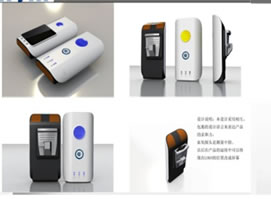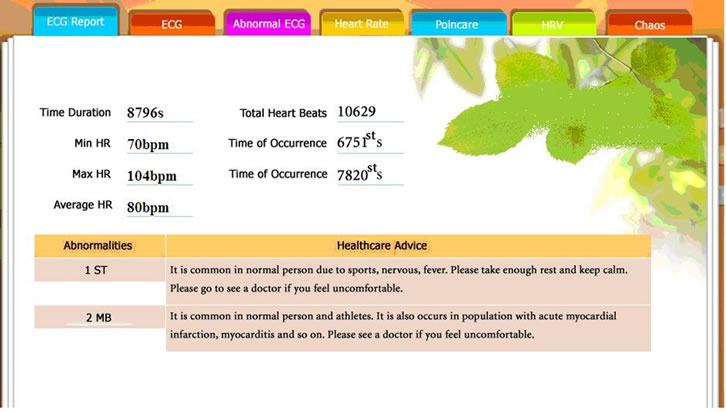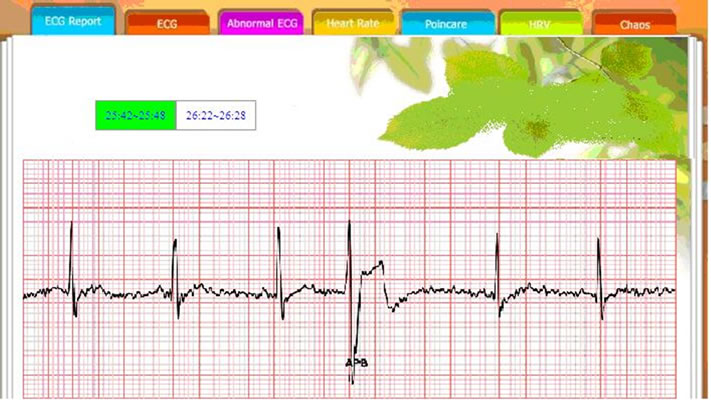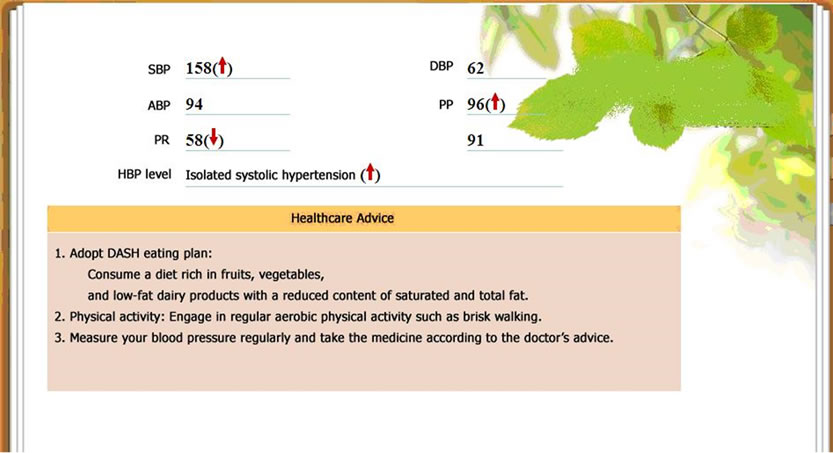E-Health Telecommunication Systems and Networks
Vol.1 No.1(2012), Article ID:18071,7 pages DOI:10.4236/etsn.2012.11003
MobiHealthcare System: Body Sensor Network Based M-Health System for Healthcare Application
1Shenzhen Institutes of Advanced Technology, Chinese Academy of Sciences, Shenzhen, China
2Taihe Hospital of Traditional Chinese Medicine, Fuyang, China
Email: ye.li@siat.ac.cn
Received March 5, 2012; revised March 26, 2012; accepted March 30, 2012
Keywords: M-Health; Body Sensor Network; Data Analysis
ABSTRACT
M-health, which is known as the practice of medical and public health supported by mobile devices such as mobile phones and PDAs for delivering medical and healthcare services, is currently being heavily developed to keep pace with the continuously rising demand for personalized healthcare. To this end, the MobiHealthcare system, which provides a personalized healthcare based on body sensor network, is developed. The system includes various body sensors to collect physiological signals specifically for different requirements, a cell phone to facilitate the joint processing of spatially and temporally collected medical data from different parts of the body for resource optimization and systematic health monitoring, a server cluster with great data storage capacity, powerful analysis capabilities to provide data storage, data mining and visualization. Compared with existing M-Health system, the MobiHealthcare system is characteristics of low coupling and powerful parallel computing capabilities. Various healthcare applications have been implemented in the proposed system to demonstrate its effectiveness in providing a powerful platform.
1. Introduction
Nowadays, the constraints in the healthcare of developing countries, including high population growth, a high burden of disease prevalence, low health care workforce, large numbers of rural inhabitants, and limited financial resources to support healthcare infrastructure and health information systems, accompanied with the improvement of potential of lowering information and transaction costs in healthcare delivery due to the explosively access of mobile phones to all segments of a country, has motivated the development of mobile health or m-health field. M-health is known as the practice of medical and public health supported by mobile devices such as mobile phones and PDAs for delivering medical and healthcare services [1]. Thus, the popularity of m-health can be subjected to the development of wearable medical devices and wireless communication technology. In order to fully utilize wireless technology between the wearable medical devices, the concept of body sensor network (BSN), which is a kind of wireless sensor network around human body, was proposed in Year 2002 with its emerging applications such as M-Health followed [2-4].

Figure 1. Illustration of body sensor network based M-Health system.
Figure 1 demonstrates a BSN based M-Health system. In a typical system, each sensor node collects various physiological signals in order to monitor the patient's health status no matter their location and then instantly transmit all information in real time to the medical server or the doctors. While an emergency is detected, the physicians will immediately inform the patient through the computer system by providing appropriate messages or alarms. Therefore, MHealth is preferred in monitoring patients in environments lack of medical doctors, such as home and workplaces.
Even though a lot of researches have been engaged in the research of M-Health system [5-8], there are a lot of key issues to be further addressed such as portable body sensors for different applications, powerful server cluster and effective data mining solution to predict the risk factor of chronic diseases, just as the theory of preventive treatment in traditional Chinese Medicine. The proposed system will integrate cloud storage, cloud computing, mobile networks and data mining technology, to realize the long-term monitoring, analysis, forecasting and management of health status at any time and any place.
The rest of this paper is organized as follows. In Section 2, the system overview is presented to provide the initial concept of the developed system. The detail components of the system for different healthcare applications are presented in Section 3. Finally, conclusions and future work are summarized in section 4.
2. MobiHealthcare System Overview
The system is comprised of four main components: body sensors for collecting physiological signals, mobile device for joint processing medical information and delivering healthcare services via mobile technology, data server cluster including the database server, data mining server and graphic server in the future, and display terminals such as Television (TV), personal computer.
In the data acquisition end, vital signals such as electrocardiograph (ECG), photoplethysmograph (PPG) and blood pressure (BP) are collected for further analysis. The collected physiological signals can be transmitted to the mobile device via Bluetooth and then to the server via Internet or 3G. By the data server cluster, the health condition can be tracked and managed by long-term health records, and thus prevent the disease, evaluate the treatment process for the users. Users can access the analysis result by a variety of interfaces such as personal computer, TV and mobile phone. MobiHealthcare system is designed to meet the requirements of different users. Three types of users are the main targets. The first group is patients with heart diseases who need a long-term monitoring after recovery to prevent its relapse. The second is hypertension patients who are under the process of medicine adjustment. The third is subhealthy people who want to have knowledge of and follow up his health conditions to prevent some kinds of chronic diseases.
3. System Architecture
In this section, four main components in the proposed system for different applications of healthcare are detailed.
3.1. Body Sensors
Body sensors developed until now for different applications are presented in Figure 2.
 (a)
(a) (b)
(b) (c)
(c)
Figure 2. Body Sensors for different applications. (a) MiniHolter; (b) 3-in-1 Portable Monitor; (c) Intelligent Sphygmomanometer.
Figure 2(a) is a miniHolter characteristic of low power consumption, resistance to deviation due to movement. With a mini-Holter, long-term ECG signal such as 48 hours can be collected continuously. It is designed for the users who need a follow-up process after recovery from heart diseases and who are under the risk of sudden heart failure. Figure 2(b) is a 3-in-1 portable monitor which can provide ECG, PPG and SPO2 collection simultaneously for users. One can use it to monitor his physiological signals whenever and wherever without any electrodes. With a 3-in-1 portable monitor, anyone with chronic diseases can have knowledge of his current situation every day, the subhealthy people can track his physiological signals and discover some abnormal trend after long-term use. Figure 2(c) is an intelligent sphygmomanometer which is designed for patients with hypertension or under the risk of hypertension. There are three key advantages of the new sphygmomanometer different from traditional ones. Firstly, the new one can record one’s blood pressure (BP) values for a long time and presents their direction of change with its
large memory and powerful interface, while the traditional ones just record the current values. Secondly, the new one can record the BP values of the family separately with a convenient user-identification scheme, which is impossible in traditional ones without an operating system. At last, as people, especially elder with hypertension, often forget to measure their BP or take the medicine according to the doctor’s advice, the new one can remind them with a pre-set alarm clock. Just because of the above three advantages, the developed sphygmomanometer can be used in different applications. For example, the doctor can use it to track the information of their patients and thus adjust the medicine prescribed. The issue of obedience between the doctor and the patient can be resolved as well.
In the future, more body sensors would be developed to meet the requirements of different people, such as intelligent glucose meter for patients with diabetes.
3.2. Mobile Device
The mobile device, which aims to jointly processing medical information and delivering healthcare services, can be various forms such as the mobile phone. Anyone with a mobile phone, can install our software specifically for the platform such as Android or iPhone, and then get the preliminary analysis result such as Heart Rate, abnormalities of a single test. The software interface is presented in Figure 3.




Figure 3 . Mobile Device with software
3.3. Data Server
There are various released public cloud platforms, such as Amazon’s EC2, Apache’s Hadoop, Microsoft’s Azure, Google’s AppEngine and so on for data process. These systems use a proprietary cloud platform to provide a personalized service. The cloud data center specifically designed for healthcare service in our system can provide a platform for great data storage, parallel computing capabilities for data mining. It can support tens of thousands of people login and upload data simultaneously with response time of less than 1 second.
According to different applications, the system has provided different functions. For mini-Holter, which is characteristic of long-term ECG monitor, the most common forms of arrhythmia, such as bigeminy, premature, Bradycardia, and the frequency of occurrence are autoanalyzed by related algorithms. The abnormal ECG signals are labeled and presented to help the users locate the abnormality quickly. Also, the indexes of Heart Rate Variability (HRV) [9] of 5 minutes are presented to evaluate the function of autonomic regulation of the heart. Some kinds of diseases such as congestive heart failure and diabetes can also be reflected from the change of HRV indexes. To realize the above functions, an automatic R-wave detection process based on threshold detection and mathematical morphology is developed on the collected ECG signals with a recognition rate of 99%. The arrhythmia phenomenon is recognized based the standard presented in [10]. Advice is given to users according to the abnormality occurred. In the future, the risk factor of some cardiovascular diseases will be researched and presented based on long-term HRV indexes. Figure 4" target="_self"> Figure 4 depicts the function specifically for mini-Holter. A summary report presented in Figure 4(a) is given to remind the user of his health condition based the extracted features. The detail extracted information such as the abnormal ECG presented in Figure 4(b) and HRV indexes are presented to provide the basis for evaluation.
 (a)
(a) (b)
(b)
Figure 4. ECG Analysis for mini-Holter. (a) Summary Report; (b) Abnormal ECG.
For 3-in-1 portable monitor, which is characteristic of short-term multi-parameter monitor, the function includes ECG analysis and PPG analysis. The ECG analysis is similar to mini-Holter, where HRV analysis is omitted as short-term ECG can not reflect the variety of heart rate. For PPG analysis, the cardiac functional indexes such as cardiac output, cardiac index and Peripheral Vascular indexes such as Blood Viscosity, stiffness index are given. The comparison between the indexes and the normal range are presented to alert the users of their abnormalities, while advice is given. Figure 5 depicts the function specifically for 3-in-1 portable monitor. A summary report is given to remind the user of his health condition based the extracted features. The detail indexes and the normal range are presented to provide the basis for evaluation.
For Intelligent sphygmomanometer, which is designed to track one’s BP values during a long time, the blood pressure level is given according to the abnormality of BP values labeled. The advice is given according to the user’s BP level. In the long-term data analysis, the tendency charts of BP values between any time duration are given to demonstrate the frequency of abnormality and thus judge the overall BP situation.

Figure 5. PPG Analysis for 3-in-1 monitor.
Figure 5 depicts the function specifically for intelligent sphygmomanometer. The single analysis is given to remind the user of his BP level, while the long-term analysis is presented to give the BP tendency during selected time duration.
In the future, the risk of some chronic diseases can be predicted based the long-term physiological signals collected with more powerful data mining solutions.
3.4. Data Visualization
There are different kinds of interfaces for the user to view his health record and the corresponding analysis results on the physiological data. For example, one can visit the health management platform, or through the TV service, as well as, he can get the analysis result and by message. The display effect on TV is shown in Figure 7.
 (a)
(a) (b)
(b)
Figure 6. BP Analysis. (a) Single analysis; (b) Long-term analysis.

Figure 7. The display effect on TV.
4. Conclusion
The MobiHealthcare system is incorporated into multiple advanced technologies, such as precise and convenient data acquisition solution, high efficiency data storage and analysis method, to monitor the health status of users at any time and any place. Through the system, people can have knowledge of his health information and even the risk factor of some chronic diseases in the future. With our system, some acute attacks can be discovered in time and chronic diseases such as hypertensions can be prevented before onset.
5. Acknowledgements
This work was supported in part by the Shenzhen Basic Research Funds for Distinguished Young Scientists (No. JC201005270306A), Key Basic Research Program of Shenzhen (No. JC201005270257A), Shenzhen Technological Achievements Promotion Program (No. CG20100 7290007A) and Key Deployment Project of Chinese Academy of Sciences (No. KGCX2-yw-904).
REFERENCES
- A. T. van Halteren, R. G. A. Bults, K. E. Wac, D. Konstantas, I. A. Widya, N. T. Dokovski, G. T. Koprinkov, V. M. Jones and R. Herzog, “Mobile Patient Monitoring: The Mobihealth System,” The Journal on Information Technology in Healthcare, Vol. 2, No. 5, 2004, pp. 365- 373.
- G. Z. Yang, “Body Sensor Networks,” Springer-Verlag, London, 2006, pp. 4-13.
- E. Jovanov, “Wireless Technology and System Integration in Body Area Networks for M-Health Applications,” 27th Annual International Conference of the Engineering in Medicine and Biology Society, Shanghai, 17-18 January 2005, pp. 7158-7160.
- E. Jovanov, C. Poon, et al., “Guest Editorial Body Sensor Networks: From Theory to Emerging Applications,” IEEE Transactions on Information Technology in Biomedicine, Vol. 13, No. 6, 2009, pp. 859-863.
- E. Monton, J. Hernandez, et al., “Body Area Network for Wireless Patient Monitoring,” IET Communications, Vol. 2, No. 2, 2008, pp. 215-222.
- K. Wac, R. Bults, et al., “Mobile Patient Monitoring: The MobiHealth System,” Annual International Conference of the IEEE Engineering in Medicine and Biology Society, Minneapolis, 3-6 September 2009, pp. 1238-1241.
- V. Jones, A. Halteren, et al., “Mobihealth: Mobile Health Services Based on Body Area Networks.” In: R. Istepanian, S. Laxminarayan and C. S. Pattichis, Eds., MHealth: Emerging Mobile Health Systems, Springer, New York, 2006, pp. 36-219.
- R. Schmidt, T. Norgall, et al., “Body Area Network BAN— A Key Infrastructure Element for Patient-Centered Medical Applications,” Biomedizinische Technik/Biomedical Engineering, Vol. 47, Suppl. 1, 2002, pp. 365-368.
- M. Malik, “For the Task Force of the ESC and NASPE. Heart Rate Variability: Standards of Measurement, Physiological Interpretation and Clinical Use,” Circulation, Vol. 93, 1996, pp. 1043-1065.
- T. B. Garcia and G. T. Miller, “Arrhythmia Recognition: The Art of Interpretation,” Jones & Bartlett Learning, Sudbury, 2004.

